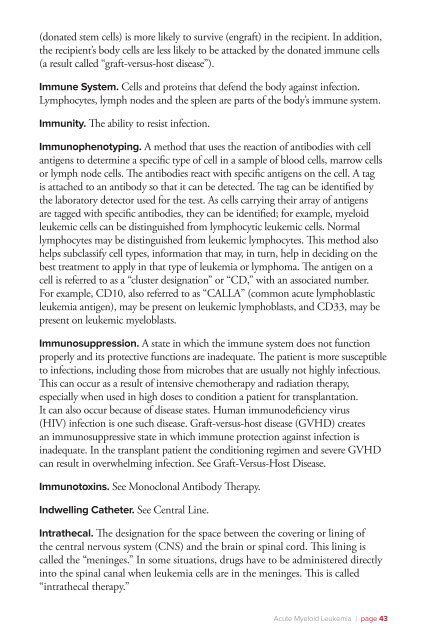Acute Myeloid Leukemia - The Leukemia & Lymphoma Society
Acute Myeloid Leukemia - The Leukemia & Lymphoma Society
Acute Myeloid Leukemia - The Leukemia & Lymphoma Society
- No tags were found...
Create successful ePaper yourself
Turn your PDF publications into a flip-book with our unique Google optimized e-Paper software.
(donated stem cells) is more likely to survive (engraft) in the recipient. In addition,the recipient’s body cells are less likely to be attacked by the donated immune cells(a result called “graft-versus-host disease”).Immune System. Cells and proteins that defend the body against infection.Lymphocytes, lymph nodes and the spleen are parts of the body’s immune system.Immunity. <strong>The</strong> ability to resist infection.Immunophenotyping. A method that uses the reaction of antibodies with cellantigens to determine a specific type of cell in a sample of blood cells, marrow cellsor lymph node cells. <strong>The</strong> antibodies react with specific antigens on the cell. A tagis attached to an antibody so that it can be detected. <strong>The</strong> tag can be identified bythe laboratory detector used for the test. As cells carrying their array of antigensare tagged with specific antibodies, they can be identified; for example, myeloidleukemic cells can be distinguished from lymphocytic leukemic cells. Normallymphocytes may be distinguished from leukemic lymphocytes. This method alsohelps subclassify cell types, information that may, in turn, help in deciding on thebest treatment to apply in that type of leukemia or lymphoma. <strong>The</strong> antigen on acell is referred to as a “cluster designation” or “CD,” with an associated number.For example, CD10, also referred to as “CALLA” (common acute lymphoblasticleukemia antigen), may be present on leukemic lymphoblasts, and CD33, may bepresent on leukemic myeloblasts.Immunosuppression. A state in which the immune system does not functionproperly and its protective functions are inadequate. <strong>The</strong> patient is more susceptibleto infections, including those from microbes that are usually not highly infectious.This can occur as a result of intensive chemotherapy and radiation therapy,especially when used in high doses to condition a patient for transplantation.It can also occur because of disease states. Human immunodeficiency virus(HIV) infection is one such disease. Graft-versus-host disease (GVHD) createsan immunosuppressive state in which immune protection against infection isinadequate. In the transplant patient the conditioning regimen and severe GVHDcan result in overwhelming infection. See Graft-Versus-Host Disease.Immunotoxins. See Monoclonal Antibody <strong>The</strong>rapy.Indwelling Catheter. See Central Line.Intrathecal. <strong>The</strong> designation for the space between the covering or lining ofthe central nervous system (CNS) and the brain or spinal cord. This lining iscalled the “meninges.” In some situations, drugs have to be administered directlyinto the spinal canal when leukemia cells are in the meninges. This is called“intrathecal therapy.”<strong>Acute</strong> <strong>Myeloid</strong> <strong>Leukemia</strong> I page 43
















